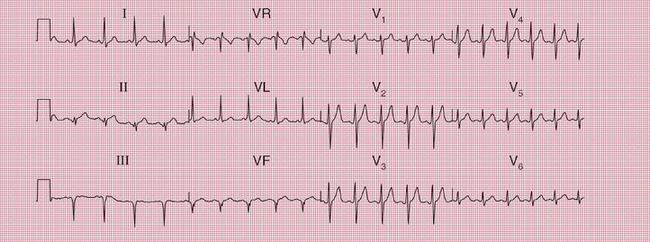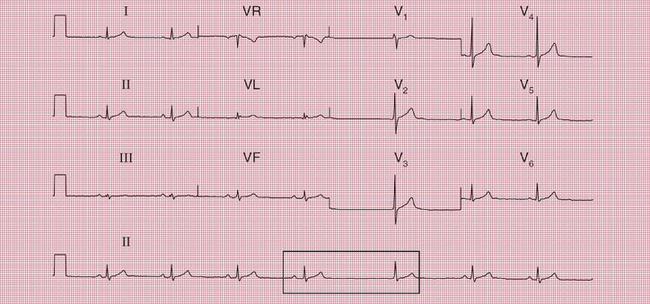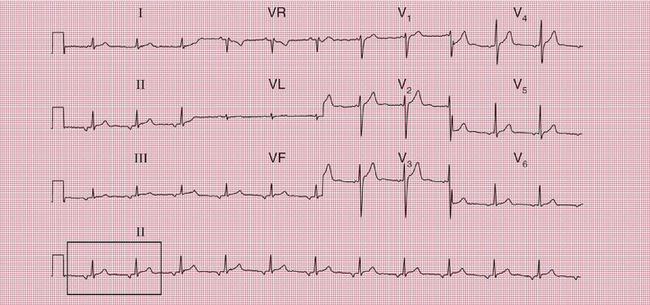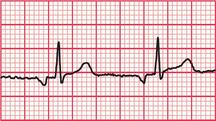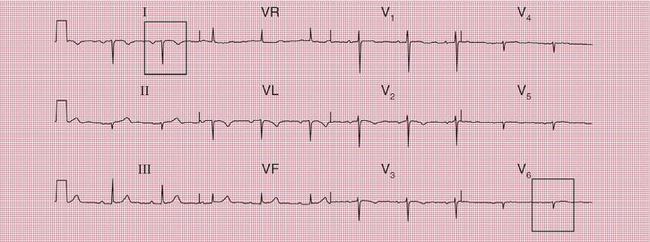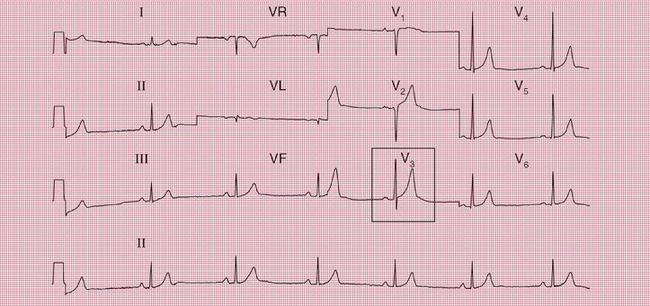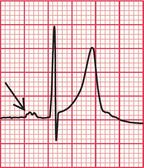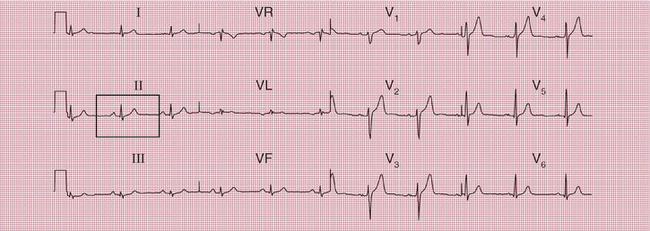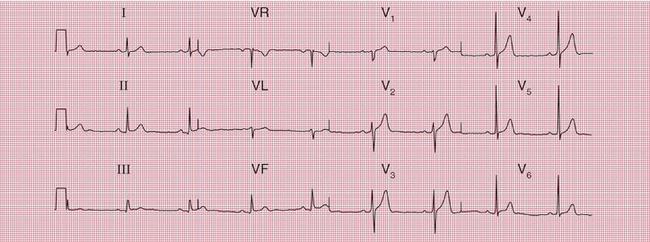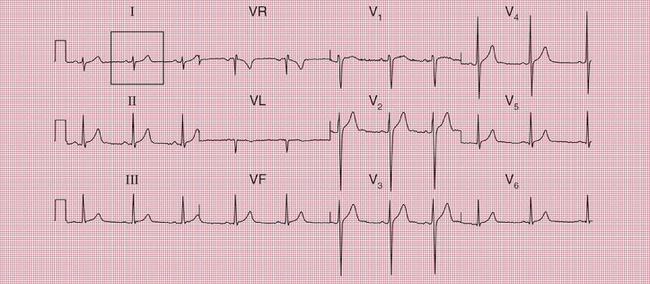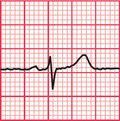1
The ECG in Healthy People
For the purposes of this chapter, we shall assume that the subject from whom the ECG was recorded is asymptomatic, and that physical examination has revealed no abnormalities. We need to consider the range of normality of the ECG, but of course we cannot escape from the fact that not all disease causes symptoms or abnormal signs, and a subject who appears healthy may not be so and may therefore have an abnormal ECG. In particular, individuals who present for screening may well have symptoms about which they have not consulted a doctor, so it cannot be assumed that an ECG obtained through a screening programme has come from a healthy subject.
THE ‘NORMAL’ ECG
THE NORMAL CARDIAC RHYTHM
Sinus rhythm is the only normal sustained rhythm. In young people the R-R interval is reduced (i.e. the heartrate is increased) during inspiration, and this is called sinus arrhythmia ( Fig. 1.1). When sinus arrhythmia is marked, it may mimic an atrial arrhythmia. However, in sinus arrhythmia each P-QRS-T complex is normal, and it is only the interval between them that changes.
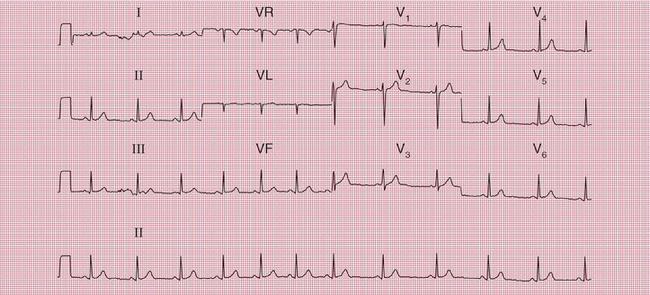
THE HEART RATE
There is no such thing as a normal heart rate, and the terms ‘tachycardia’ and ‘bradycardia’ should be used with care. There is no point at which a high heart rate in sinus rhythm has to be called ‘sinus tachycardia’ and there is no upper limit for ‘sinus bradycardia’. Nevertheless, unexpectedly fast or slow rates do need an explanation.
SINUS TACHYCARDIA
The ECG in Figure 1.2 was recorded from a young woman who complained of a fast heart rate. She had no other symptoms, but was anxious. There were no other abnormalities on examination, and her blood count and thyroid function tests were normal.
Box 1.1 shows possible causes of sinus rhythm with a fast heart rate.
SINUS BRADYCARDIA
The ECG in Figure 1.3 was recorded from a young professional footballer. His heart rate was 44/min, and at one point the sinus rate became so slow that a junctional escape beat appeared.
The possible causes of sinus rhythm with a slow heart rate are summarized in Box 1.2.
EXTRASYSTOLES
Supraventricular extrasystoles, either atrial or junctional (AV nodal), occur commonly in normal people and are of no significance. Atrial extrasystoles ( Fig. 1.4) have an abnormal P wave; in junctional extra-systoles either there is no P wave or the P wave may follow the QRS complex.


Fig. 1.4 Supraventricular extrasystole
Note
• In supraventricular extrasystoles the QRS complex and the T wave are the same as in the sinus beat
• The fourth beat has an abnormal P wave and therefore an atrial origin
Ventricular extrasystoles are also commonly seen in normal ECGs ( Fig. 1.5).
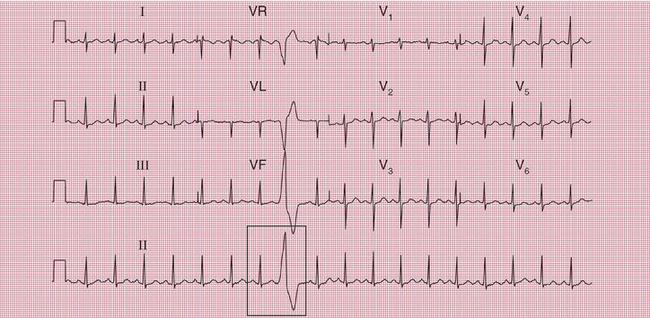
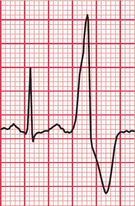
Fig. 1.5 Ventricular extrasystole
Note
• Sinus rhythm, with one ventricular extrasystole
• Extrasystole has a wide and abnormal QRS complex and an abnormal T wave
In healthy people, normal sinus rhythm may be replaced by what are, in effect, repeated atrial extra-systoles. This is sometimes called an ‘ectopic atrial rhythm’ and it is of no particular significance ( Fig. 1.6).
THE P WAVE
In sinus rhythm, the P wave is normally upright in all leads except VR. When the QRS complex is predominantly downward in lead VL, the P wave may also be inverted ( Fig. 1.7).
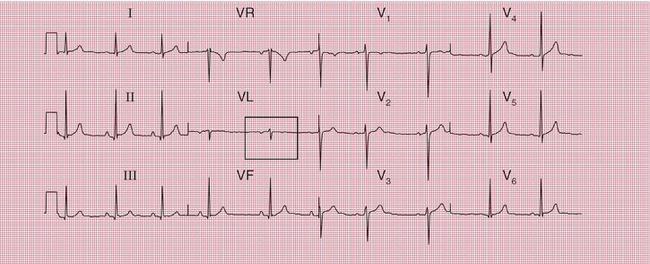

In patients with dextrocardia the P wave is inverted in lead I ( Fig. 1.8). In practice this is more often seen if the limb leads have been wrongly attached, but dextrocardia can be recognized if leads V5 and V6, which normally ‘look at’ the left ventricle, show a predominantly downward QRS complex.
If the ECG of a patient with dextrocardia is repeated with the limb leads reversed, and the chest leads are placed on the right side of the chest instead of the left, in corresponding positions, the ECG becomes like that of a normal patient ( Fig. 1.9).
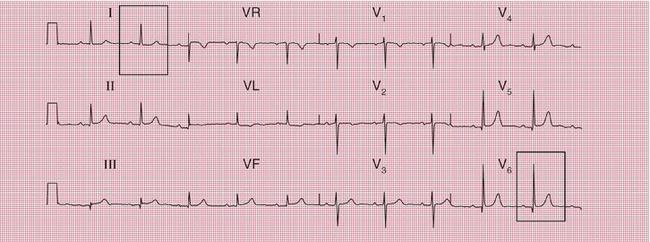
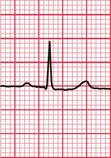
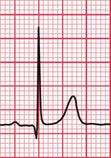
Fig. 1.9 Dextrocardia, leads reversed
Note
Upright P wave and QRS complex in lead I
A notched or bifid P wave is the hallmark of left atrial hypertrophy, and peaked P waves indicate right atrial hypertrophy – but bifid or peaked P waves can also be seen with normal hearts ( Fig. 1.10).
THE PR INTERVAL
In sinus rhythm, the PR interval is constant and its normal range is 120-200 ms (3-5 small squares of ECG paper) ( Fig. 1.11). In atrial extrasystoles, or ectopic atrial rhythms, the PR interval may be short, and a PR interval of less than 120 ms suggests pre-excitation.
PR interval ‘abnormalities’ will be discussed further in the context of normal people in Chapter 2.
THE QRS COMPLE
THE CARDIAC AXIS
There is a fairly wide range of normality in the direction of the cardiac axis. In most people the QRS complex is tallest in lead II, but in leads I and III the QRS complex is also predominantly upright (i.e. the R wave is greater than the S wave) ( Fig. 1.12).
The cardiac axis is still perfectly normal when the R wave and S wave are equal in lead I: this is common in tall people ( Fig. 1.13).
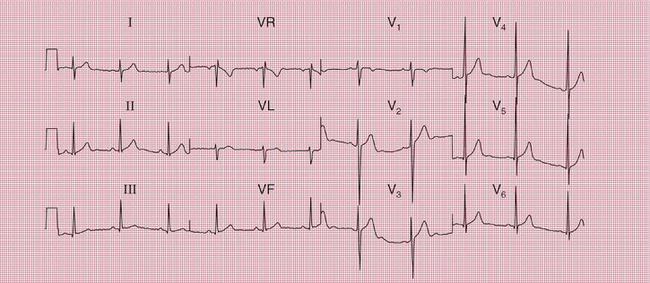
When the S wave is greater than the R wave in lead I, right axis deviation is present. However, this is very common in perfectly normal people. The ECG in Figure 1.14 is from a professional footballer.
It is common for the S wave to be greater than the R wave in lead III, and the cardiac axis can still be considered normal when the S wave equals the R wave in lead II ( Fig. 1.15). These patterns are common in fat people and during pregnancy.
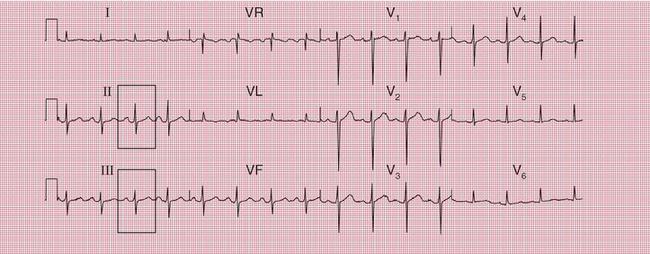


• This shows the ‘leftward limit’ of normality of the cardiac axis
• S wave equals R wave in lead II
When the depth of the S wave exceeds the height of the R wave in lead II, left axis deviation is present (see Figs 2.25 and 2.26).
THE SIZE OF R AND S WAVES IN THE CHEST LEADS
In lead V1 there should be a small R wave and a deep S wave, and the balance between the two should change progressively from V1 to V6. In lead V6 there should be a tall R wave and no S wave ( Fig. 1.16).
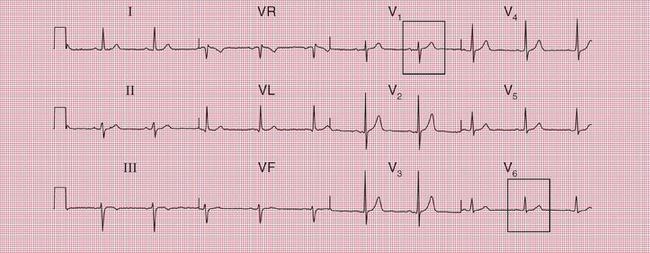


• Lead V1 shows a predominantly downward complex, with the S wave greater than the R wave
• Lead V6 shows an upright complex, with a dominant R wave and a tiny S wave
Typically the ‘transition point’, when the R and S waves are equal, is seen in lead V3 or V4 but there is quite a lot of variation. Figure 1.17 shows an ECG in which the transition point is somewhere between leads V3 and V4.
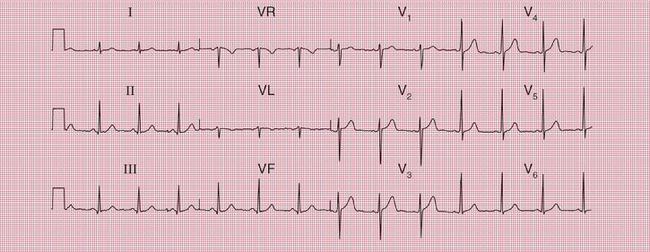
Figure 1.18 shows an ECG with a transition point between leads V4 and V5, and Figure 1.19 shows an ECG with a transition point between leads V2 and V3.
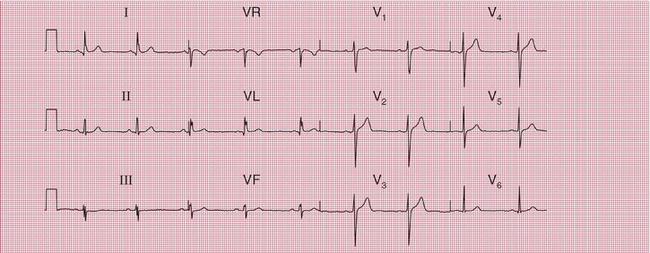
< div class='tao-gold-member'>
Stay updated, free articles. Join our Telegram channel

Full access? Get Clinical Tree


